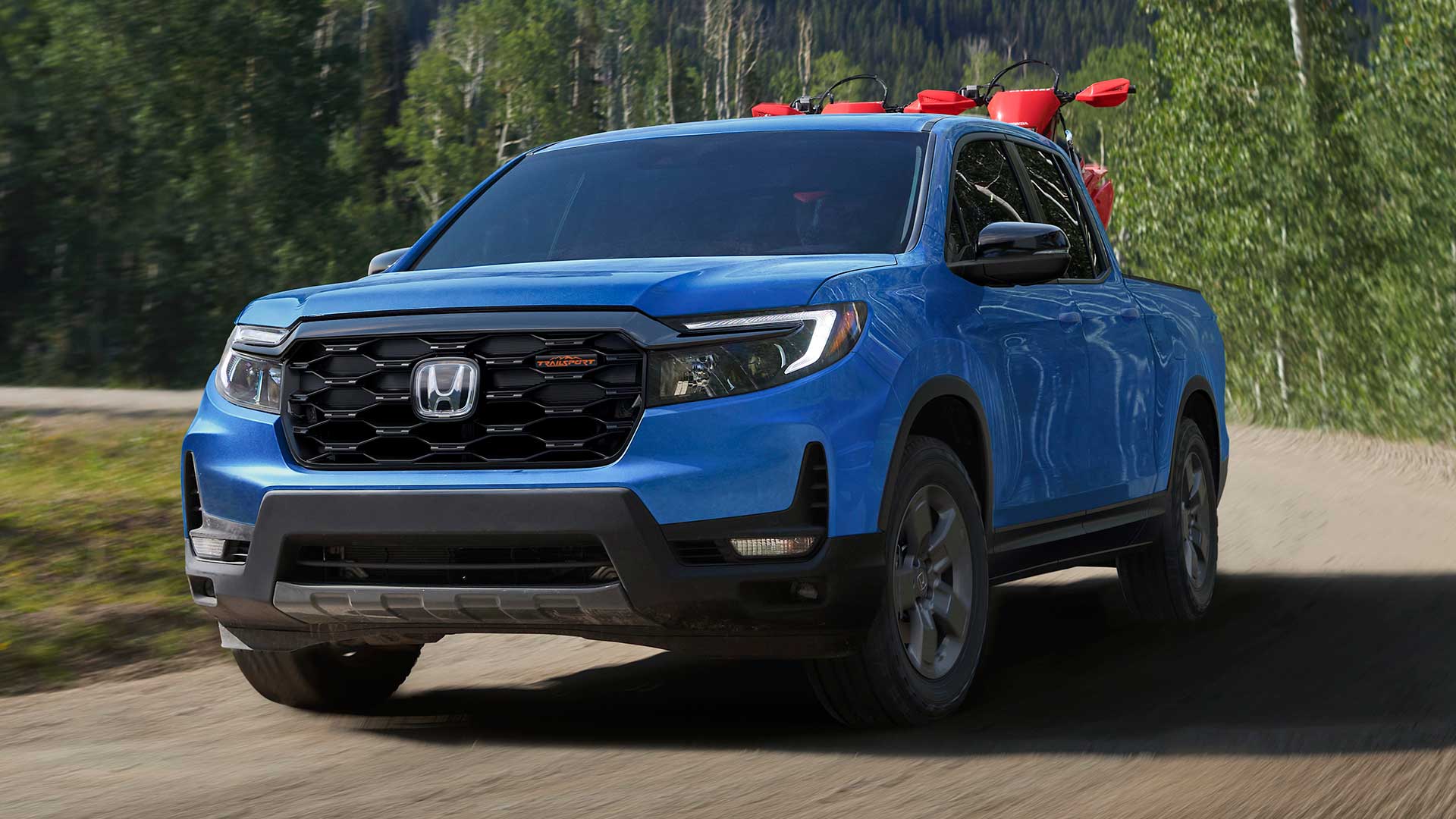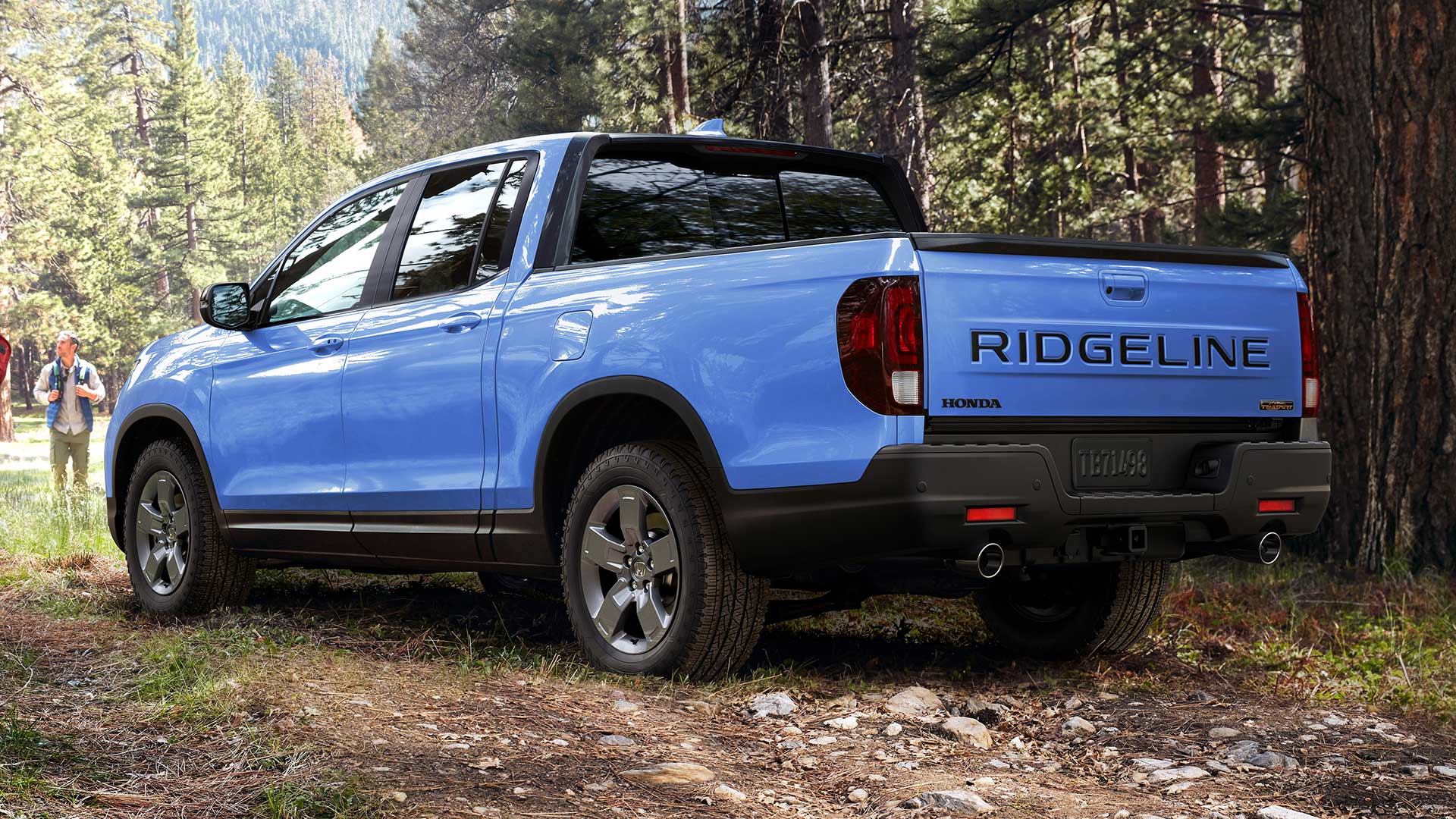2010 Kia Forte
Ever since Hyundai acquired rival Kia, it’s been a full throttle effort to transform the Korean brand’s image from a maker of inexpensive, basic use vehicles, to a high quality, mainstream mark. But their latest effort, the compact Forte, goes head-to-head against industry benchmarks Toyota Corolla and Honda Civic. While the Forte is clearly the most handsome Kia small car ever, it needs more than looks to stay in this race.
The all-new 2010 Forte is a breath of fresh air for the Kia lineup, and simply saying it replaces the generic Spectra would grossly underrate its potential impact.
Available now in a Sedan and Koup, with a “K”, its slightly edgy, American-sourced styling strikes a richer stance than any other Asian mass market small car.
The front-end of our test Forte Sedan, with its flared headlamps, smart-looking grille, and clam shell hood, does have a passing resemblance to the Honda Civic.
But, the well drawn character lines, and up swept side glass, give the Forte Sedan a sharp profile that is its own, and 15, 16, and 17-inch wheels and tires, along with a beefy rear-end, with wrapped and sectioned taillamp housings, cement the image of a well built small sedan.
The front drive Forte finds power from two variable timing I4s. LX and EX trim use a 2.0-liter with 156 horsepower and 144 pound-feet of torque. Our SX sports a 2.4-liter with 173 horsepower and 168 pound-feet of torque. That beats the Toyota Corolla XRS.
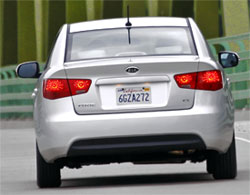 A five-speed manual is standard, with an optional four-speed automatic for LX and EX trim. The SX starts with a 6-speed manual, with a 5-speed automatic on our car.
A five-speed manual is standard, with an optional four-speed automatic for LX and EX trim. The SX starts with a 6-speed manual, with a 5-speed automatic on our car.
Even with more power, Government Fuel Economy ratings for our SX are class competitive at 23 city/31 highway using regular gas. We managed an okay 27.6 miles per gallon in real world driving.
The Forte’s Energy Impact Score is 13.2 barrels of oil consumed per year, with a concise Carbon Footprint of 7.1 annual tons of CO2 emitted.
But, that car will be more sluggish than our SX which still needed 8.9 seconds to accelerate from 0 to 60, finishing the quarter mile in 16.8 seconds at 84 miles per hour. Off the line, the Forte felt energetic, with a good hookup, and steady power build. But the pace was hurt by slow shifts. And, while Kia engines have come a long way, our car’s 2.4 was still buzzier and less refined than top rivals.
Ride and handling show even more improvement. The Forte’s front strut and rear torsion beam suspension adds standard Electronic Stability and Traction control. A high value plus over most rivals.
And it showed. Through the cones our car felt very solid, with no flexy or flimsy feel. Steering is nicely responsive. Front push does come on quickly, so Forte is not as nimble or fun-to-drive as the all-independent Civic. But, it gets through with less body roll.
On more typical pavement, we found the Forte’s ride to be more sophisticated than we expected as well. Not soft, but not stiff either. Here, the Forte is more akin to the Corolla XRS.
The Forte’s Brakes are well above class average. Four-wheel discs with standard ABS and Brake Assist. Hard stops proved short at only 122 feet from 60. Stability was great. The pedal could have more feel but that’s a nit-pick.
The Forte’s cabin matches the exterior. It’s far more inviting than the Spectra, with a Civic and Corolla beating 96.8 cubic feet of passenger space.
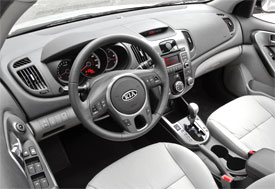 The dash design is a toned-down version of the Kia Soul, with its overlapping gauges and boogey-board shaped center stack.
The dash design is a toned-down version of the Kia Soul, with its overlapping gauges and boogey-board shaped center stack.
Seats are comfortable and well formed with leather an option on our top-level SX, which also included a tilt/telescoping steering wheel.
Forte standard equipment includes six airbags, a CD/MP3/satellite radio, USB port, and Bluetooth. But, air conditioning is an option on the LX.
The rear seats offer decent legroom - even for a six footer - as well as a standard 60/40 split folding feature which extends an already highly useful 14.7 cubic foot trunk.
Pricing for the Kia Forte starts at $14,390 for the LX. That’s over $1700 less than the less well equipped Corolla and Civic. The spread widens with the mid-level Forte EX at $16,490, and top-tier SX at $17,890. And all Fortes come with Kia’s 10 year/100,000 mile powertrain warranty.
Wow. We knew going in the 2010 Forte to be a generational improvement in Kia small cars. But, to be a serious alternative to the Civic and Corolla is packaging, power and economy, ride and handling, and style, is a surprise. But then Kia has been surprising us for years, and the compact Forte is just their latest tour to force.
Specifications
- Engine: Sx 2.4-Liter
- Horsepower: 173
- Torque: 168 Lb Feet
- 0-60 MPH: 8.9 Seconds
- 1/4 Mile: 16.8 Seconds @ 84 MPH
- 60-0 MPH: 122 Feet
- EPA: 23 MPG City/ 31 MPG Highway
- Mixed Loop: 27.6 MPG
- Energy Impact: 13.2 Barrels Oil/Yr
- CO2 Emissions: 7.1 Tons/Yr
2024 Honda Ridgeline TrailSport
It Does Truck-Like Things Better Than Ever
Honda brought something truly unique to the pickup truck scene when their mid-size Ridgeline debuted for 2006. In 2017, it moved towards becoming a little more true truck-like, both in form and capability, now with yet another step in that direction for 2024. So, let’s see if the Ridgeline is really hitting its stride.
For 2024, it’s all about making this Honda Ridgeline better than ever. There are styling tweaks outside, along with tech and functional improvements inside, but the biggest news is the Ridgeline has now joined Honda’s TrailSport family of off-road inspired vehicles. This more-true-trucklike, second-gen Ridgeline been around since 2017, receiving periodic updates over the years; but joining the TrailSport family is the biggest leap yet.
Primarily, the TrailSport transformation includes General Grabber all-terrain tires, mounted on new Pewter Gray 18-inch wheels, steel underbody protection, and retuning the strut front, and multi-link rear suspension for added wheel articulation. And while we always appreciate the additional traction of off-road tires, the Ridgeline’s standard i-VTM4 all-wheel drive, with Intelligent Traction Management and snow, sand, and mud settings, was already quite capable of handling all but the most extreme off-roading, ground clearance of just 7.6 inches being it’s only real hinderance.
A 3.5-liter V6 remains under the hood as it has since the Ridgeline debuted for 2006; the current version outputs 280 horsepower and 262 lb-ft of torque, plenty enough muscle to handle its 5,000-lbs. towing capacity. A nine-speed automatic transmission with paddle shifters and bevy of push and pull buttons on the console replaced the six-speed automatic back in 2020.
In addition to adding TrailSport capability, a big focus for this update was making it more user-friendly inside, starting with the central touchscreen growing from 8 to 9 inches. It also gets faster processing speeds, menus have been simplified, and the native navigation system is improved with better graphics. It’s accompanied by a new digital instrument cluster, along with an upgraded center console with more storage space. Unique TrailSport touches include heavy duty floormats, leather-trimmed seats, orange stitching throughout the cabin, and orange ambient lighting.
The Ridgeline continues to offer things available nowhere else in the pickup truck market.
Exterior styling doesn’t exactly shout “macho big rig coming your way,” but the more vertical face and larger grille that arrived for 2021, along with this year’s added TrailSport elements, do continue to toughen up the Ridgeline’s image. The 5’4” bed remains highly functional with no large wheel well intrusions, multiple tie-downs points, lighting and even speakers. And of course, the Ridgeline continues to offer things available nowhere else in the pickup truck market, like the dual-action tailgate, and large, lockable, drainable, underbed storage. Not to mention being able to drive around in true car-like comfort, something we took full advantage of on our way to our Mason Dixon Dragway test track.
There was great grip off the line, with full power arriving smoothly but quickly, helping us to get to 60 in 7.0 seconds flat, a tenth quicker than the last Ridgeline we tested. That power delivery stayed fairly consistent the whole way down the track, barely interrupted by the nine-speed automatic’s smooth shifting. Our best quarter-mile run was 15.5 seconds at 90 mph.
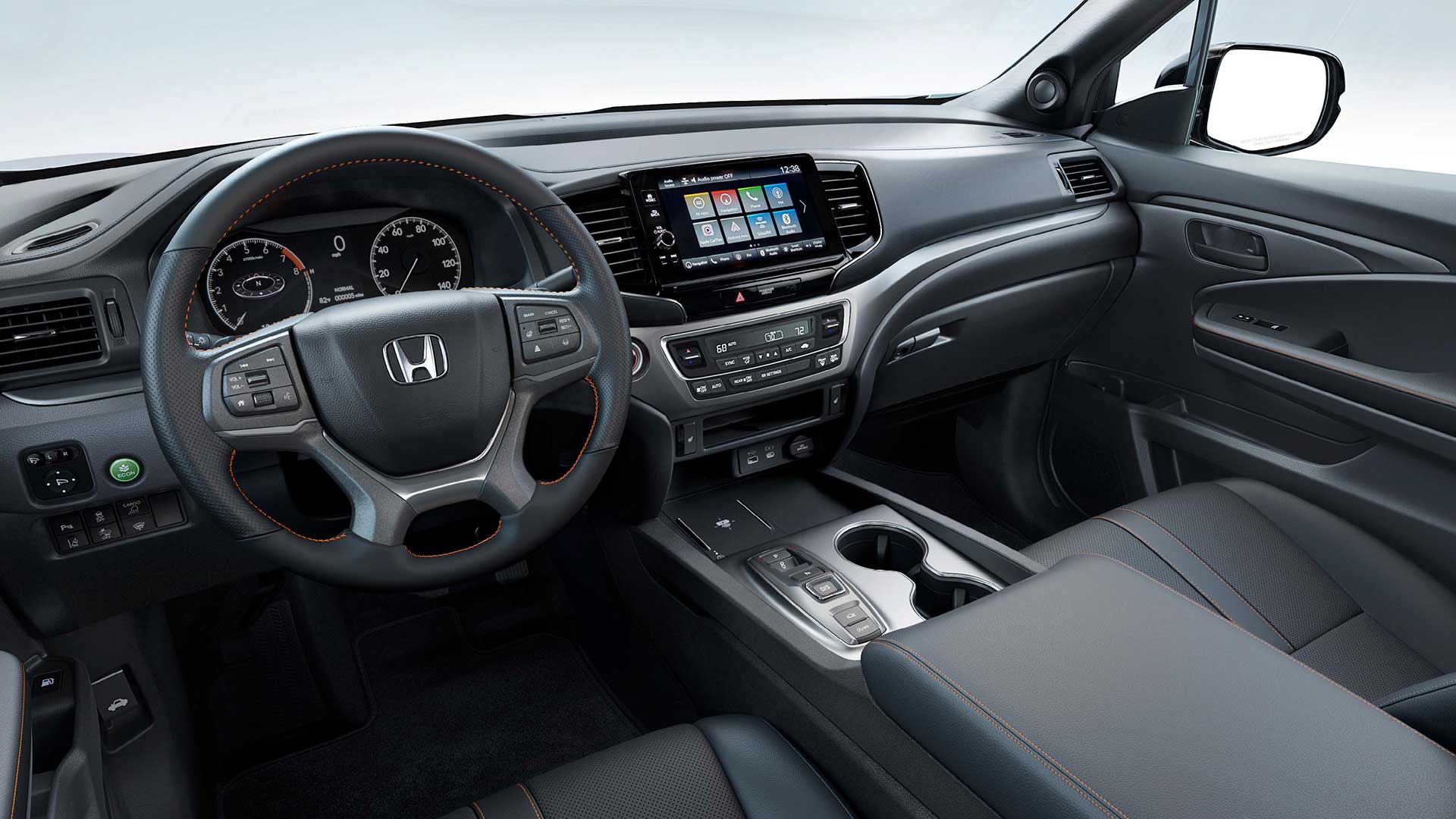
The revised suspension and knobbier tires didn’t really seem to add or detract from handling prowess, as it felt as solid, nimble, and car-like as it always has through our cone course. Perhaps a little less stiff than before, but good feedback, tight steering, and minimal body roll for a pickup, made for a very confidence inspiring experience. In our braking test, we stopped in a respectable average of 123 feet from 60, with only moderate amounts of nosedive and good feel through the pedal.
There is, however, a slight reduction in Government Fuel Economy Ratings with the all-terrain tires; 18-City, 23-Highway, and 20-Combined, our average, right on, at 20.4 mpg of Regular. That’s a slightly below average Energy Impact Score of 14.9 barrels of yearly oil use, with CO2 emissions of 7.4 tons.
TrailSport pricing falls in line just under the Ridgeline’s top Black Edition trim with a starting price of $46,375, about five grand over a base Ridgeline Sport.
So, whether you consider the Honda Ridgeline to be a “real” truck or not, this ruggedly smooth 2024 TrailSport does truck-like things better than ever. And we’re not just talking about the slight upgrade in off-road performance, we’re talking about a flexible bed to help you get chores done, and the ability to tow or haul with comfort and flexibility other trucks can only wish for. It’s why the Ridgeline brings more first-time buyers to Honda than any other vehicle, and why it continues to be a great choice in the growing midsize truck realm.
Specifications
- Engine: 3.5-liter V6
- Transmission: 9-speed automatic
- Horsepower: 280
- Torque: 262 lb-ft
- EPA: 18 City | 23 Highway | 20 Combined
- 0-60 mph: 7.0 seconds
- 1/4 Mile: 15.5 seconds at 90 mph
- 60-0 Braking (avg): 123 feet
- MW Fuel Economy: 20.4 mpg (Regular)
- Max Towing Capacity: 5,000-lbs








